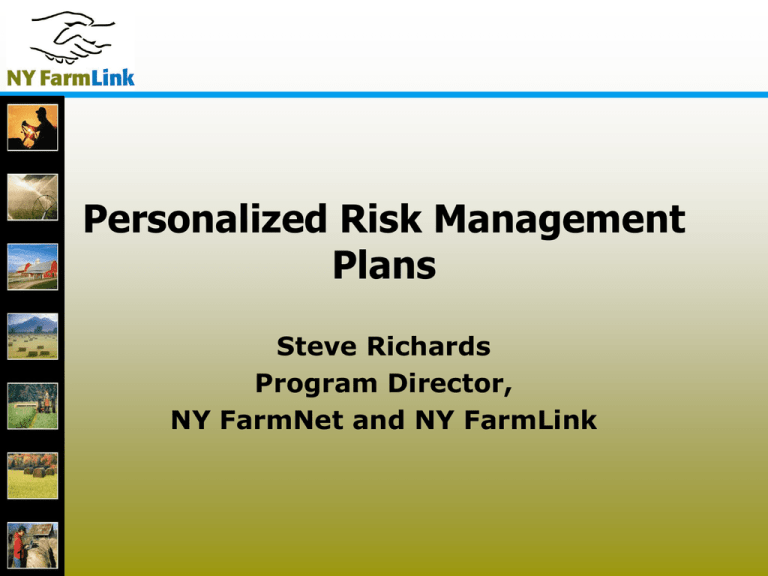Personalized Risk Management Plans Steve Richards Program Director,
advertisement

Personalized Risk Management Plans Steve Richards Program Director, NY FarmNet and NY FarmLink 1 Risk Management Checklist Was initially created to address those areas that might be sensitive (family or HR type issues). Also addresses those issue which producers have very little patience for (Crop Insurance, for example). 3 trainings for FarmNet consultants have been held to train them to be proficient and consistent in filling out the checklist. There are NY FarmNet/NY FarmLink workbooks to back up almost every area of risk. They are free to farmers who complete the checklist. 2 Risk Management Checklist Accompanied by a consultant trained in the 5 areas of risk. The consultant reviews the risks with the farm business. In the farmer’s opinion, what are the risks on his/her farm. Works with consultant to identify strategies to mitigate risks. The last page is a review of what the farmer will do in the next year to reduce risks to their operation. 50 performed in 2004. 50 more in 2005. 3 Human Resource Risk Some Key Risk Management Strategies: Buy-sell agreements between business partners Life Insurance on key family members/employees Disability Insurance and/or paying the minimum SE tax to obtain disability benefits. Power of attorney for finances for the key members of the business. Health Insurance, Medicare, Medicaid, State and Federal Programs. Business transfer and succession Estate planning Good communication and HR practices 4 Legal Risk Management Some Key Risk Management Strategies: Review liability/casualty insurance policies Changing business structure to a structure with liability protection (LLC, Corps) Update current legal agreements. Get all contracts in writing. Periodic review with attorney and insurance agent. Environmental liability and certification, neighbor relations. 5 Financial Risk Management Some Key Risk Management Strategies: Record Keeping Communications with lender and accountant Meeting cash flow requirements Examining industry trends and planning accordingly. Cost control through better management practices Investing off the farm to balance portfolio Increasing profit growth 6 Production Risk Management Some Key Risk Management Strategies: Crop Insurance! Yield based vs. Revenue based Crop production practices 7 Marketing Risk Management Some Key Risk Management Strategies: Price risk management, contracting Marketing plans/clubs Futures, options, etc. Direct marketing and the skill of marketing. 8 Results There is always an area of risk that can be mitigated easily, quickly, and cheaply. Every farm has different risk exposure Example: Crop Insurance vs. Health Insurance At least 2 different consulting firms are using this checklist with their clients. RMA has mentioned that in the future there may be a producer discount on crop insurance if they have completed one of these plans 9 Workbook #1: Do I Need Crop Insurance? Steve Richards Program Director NY FarmNet NY FarmLink 10 Do I Need Crop Insurance? Chapters in Workbook: 1. 2. 3. 4. What is your risk exposure? How large of a loss can you afford? What are your crop insurance options? Comparing Yield based, Revenue based, and Catastrophic coverages. 5. Should you buy crop insurance or selfinsure? 11 What is Your Risk Exposure? What kinds of losses are likely on your farm? Look through your records What has been the variability in the yields you have had (per crop and total) What has been the variability in the income from your farm operation? What % loss is probable? 12 10%, 20%, 30%, 100%?? What is the value of your Probable Loss? Crop 20% Loss 40% Loss 60% Loss 80% Loss Total Loss 40% Loss -$36,000 60% Loss -$54,000 80% Loss -$72,000 Total Loss -$90,000 Total Example Crop Corn 13 20% Loss -$18,000 What Makes Your Business More Vulnerable to Risk? Stage in Business Life Cycle: Start up vs. Established Recent Losses Had a loss last year? Can you afford 2 in a row? Undergoing business or family changes 14 Changes in family living costs Transferring business from one generation to next How Large of a Loss Can You Afford to Absorb? Absorb through Equity: Have sufficient assets (i.e. cash or ability to borrow money) in reserve to cover loss Cash Flow: have sufficient cash flow during the year to cover the loss. Combination: by adding up reserves and “excess” cash flow, you can arrive at your MAXIMUM ABSORBABLE LOSS 15 What is Your Maximum Absorbable Loss? Maximum allowable drop in equity: Plus: Maximum funds available from cash flow: Equals: Total amount of absorbable losses $_______ $_______ $_______ Example Example: Total losses that would be absorbable Maximum allowable drop in equity: Plus: Maximum funds from cash flow: Equals: Total amount of absorbable losses 16 $23,227 $6,000 $29,227 Crop Insurance Options: Crop Insurance Acronyms AGR-- Adjusted Gross Revenue APH--Actual Production History CAT--Catastrophic Risk Protection CCC--Commodity Credit Corporation CIH--Crop Insurance Handbook FSA--Farm Service Agency FCIC--Federal Crop Insurance Corporation 17 Crop Insurance Options: Crop Insurance Acronyms LAM--Loss Adjustment Manual MPCI--Multiple Peril Crop Insurance NAP – Non Insured Crop Disaster Assistance Program PHTS--Policyholder Tracking System RMA--Risk Management Agency Units: parcels of land that are insured separately from other parcels (units) of land. USDA--United States Department of Agriculture 18 Crop Insurance Options: Crop Insurance Dates Sales Closing Date: Last date to purchase a policy Cancellation Date: Last date to cancel policy Production Reporting Date: Date to report yields and plantings for previous crop year. Acreage Reporting Date: the date to report containing all acreage of insured crop in a county. Final Planting Date: The date by which the insured crop must be planted in order to receive full coverage. 19 Myths About Crop Insurance It Doesn’t Pay: For every dollar paid in premiums, the Federal Crop Insurance Program has paid out $3.93. (premiums are subsidized). It Costs Too Much: For the level of coverage purchased, the price is lower than most other insurances (car, etc.) My Crops aren’t covered: There is at least minimum coverage for every crop. There may not be higher levels of coverage, depending on what crop you are growing. 20 Myths About Crop Insurance You have to have a total loss to collect: Losses that qualify for coverage range from 10% to 50%, depending upon which policy is chosen. You have to use the county average: Not if you have adequate production records. There is too much paperwork: The crop insurance agent will help you with much of the paperwork. 21 Types of Crop Insurance Catastrophic Coverage Policies: Includes (CAT) and (NAP) policies. Crop Yield Coverage Policies: Multiple Peril Crop Insurance (MPCI) type of policies. The plans pay out a certain % of yield at a certain % of price. Income Coverage Policies: Adjusted Gross Revenue (AGR), Indexed Income Protection (IIP), and Crop Revenue Coverage (CRC) type of policies. The plan pays out at a certain % of insured income at a certain % of the loss. 22 Typical Policies MPCI-APH Characteristics Loss Based On Yield Coverage Price Coverage Revenue Coverage Catastrophic Coverage 23 Actual Yield MPCI-Dollar Dollar amt per unit selected You choose % Dollars rec'd Coverage level for crop CRC Farm Revenue 50%-85% Ave Production Feb avg/Dec You choose % Insured dollar CBOT or Oct. Coverage level amt. chosen avg Dec CBOT Not Dollars lost by Losses due to Applicable reduced yield price & yield Not Available Available Available IIP AGR/AGRLITE Revenue History Based on gross revenue Februar y's average of Dec CBOT Los ses due to price & yield Adj. Gross Revenue Based on gross revenue Available Based on gross revenue Based on gross revenue Not Available Mechanics of Crop Insurance Crop insurance comes in two numbers: one is based on the insurable amount (either yield or revenue) and the other is the payout (less a deductible percentage). Examples: Cat 50/55 MPCI “Buy-up” 75/100 AGR-Lite 80/90 24 Mechanics of Crop Insurance Example: You buy a policy that has 80/90 written on it: 80: coverage level The first number is the “trigger”, after which the policy begins to pay. So, in order for this policy to start covering, you must have had at least a 20% loss. 90: Payout level The second number is the payout level, less any deductible percentage. In this case, any loss over 20% would be compensated by this policy at .90 per dollar. 25 Which Policy To Choose? What crops do you grow? Where are you located? What kind of loss are you more likely to experience? Yield losses? MPCI type products Yield and Price Losses? IIP and CRC type products Revenue Losses? AGR and AGR-Lite products Catastrophic coverage? Available for all crops Small administrative fee ($100 per crop) Small coverage level as well (50/55) 26 Comparing Insurance Products Choosing a coverage level You have calculated your probable loss You have calculated your absorbable loss You want to pick a coverage level that is above your maximum absorbable loss! In the example $29,277 represented a over a 30% loss, so our farmer would want to pick a coverage level no less than 70%. The only trick is to convert dollars into yield or visa vesa. The workbook will help you. 27 Deciding if You Should Buy Crop Insurance Likely frequency of crop losses This is tricky, its betting on the weather. Likely frequency of crop losses that would be covered by insurance, In our example, this is a loss greater than 30%. 28 Should you Buy Insurance or Self Insure? What is the maximum premium you should be willing to pay? Basically, you compare the years it would take to recover from a loss with and without insurance (with insurance payouts being reduced by premium payments). When the value of the insurance is greater than the premium, you should be willing to purchase the insurance, right? 29 Appendix: How to File a Claim! Other than dashed expectations of what was thought to have been covered, most other mistakes occur in reporting losses. Contact your crop insurance agent within 72 hours of initial discovery of damage. Do not destroy or harvest your crop until you have spoken to your insurance agent and an adjuster has given you permission to do so. 30 Workbook Results The workbook has been used for 4 presentations so far in New York. Over 200 copies of the workbook have been distributed to producers. A copy has been given to each FSA office in New York. Was included in the 2005 Risk Management Notebook. 31 Workbook #2: Using Crop Insurance Profiles of 13 Farms Steve Richards Program Director, NY FarmNet/NY FarmLink 32 Profiles Booklet Farmer to Farmer learning Selected stories of experiences with crop insurance Variety of commodities, farm sizes, and marketing practices. Introduction: Dispelling myths about crop insurance, summarizing available products. Appendix: Crop insurance terms and acronyms, grower responsibilities, and sources for additional information. 33 Profiles Booklet Examples Mary and Frank Heyer Diversified vegetable/NAP Roy and Connie Ike Field Crops/MPCI-APH Wilhugh Farm AGR and MPCI-APH on forages 34 Profiles Booklet Results Farmers really like the booklet. The workbook has been distributed with all of the Risk Management 2005 notebooks. A copy of the workbook is in each FSA office. At least 150 copies distributed to producers so far in 2004/2005. 35

